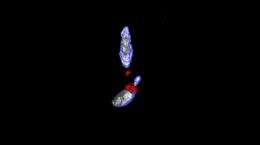A new target to inhibit malaria and toxoplasmosis infection

Maryse Lebrun, Research Director at Inserm, and her fellow researchers at the Laboratoire Dynamique des interactions membranaires normales et pathologiques (CNRS, France), have characterised a protein complex that allows the agents that cause malaria and toxoplasmosis to infect host cells. This is a highly original mechanism, since the parasite supplies both the receptor which it inserts into the host cell membrane and the ligand it exposes at its surface. The researchers have now shown the three-dimensional structure of this complex. The new data is published in Science on 22 July 2011. It paves the way for new drugs designed to inhibit the formation of the protein complex in question and block invasion by Plasmodium falciparum in red blood cells.
Apicomplexa form a huge family of parasites that cause many different illnesses in humans and animals, and which includes Plasmodium, the parasite that causes malaria and Toxoplasma gondii, the agent that causes toxoplasmosis. Over a million people die of malaria every year. Over a third of the world's population is at risk and the parasite has developed resistance to most of the anti-malaria drugs currently available. Toxoplasmosis is one of the most widespread congenital infections.
Intracellular parasites such as these penetrate inside the cells of the infected organism. The research laboratory in Montpellier is investigating the mechanisms related to invasion of the host cell, a crucial step in the development of infection, the specific nature of which they want to identify so that new treatment targets can be designed.
Researchers at Inserm and the CNRS recently deciphered the mechanism used by Apicomplexa to penetrate the cell, at cellular and molecular level. This involves a protein complex that assembles at the interface between the host cell membrane and the parasite membrane, forming a structure known as a moving junction (MJ). This is a highly original mechanism, since the parasite supplies both the receptor (RON2) which it inserts into the host cell membrane and the ligand (AMA1) which it exposes at its surface. These proteins are not present in the host, so this mechanism is specific to Apicomplexa parasites. The researchers have identified a short-peptide region in RON2 capable of binding AMA1 which has very strong affinity and inhibits invasion by the parasite.
In collaboration with a Canadian team (University of Victoria, Vancouver), the researchers crystallised the AMA1- RON2 peptide complex in Toxoplasma and mapped out the amino acids necessary for AMA1 and RON2 to interact and form the MJ in vivo. The RON2 peptide is inserted into a hydrophobic groove in AMA1, allowing the parasite to overcome the mechanical constraints it encounters as it invades the host cell. “By analysing the relation between structure and function and modelling the equivalent Plasmodium falciparum complex, we were able to identify an area on RON2 that is strongly implicated in the interaction specific to the various Apicomplexa parasites and thus understand the mechanisms used by antibodies targeting AMA1 to inhibit invasion,” explained Maryse Lebrun. Together, all this data can be used as the basis for developing drugs able to inhibit assembly of the AMA1-RON2 complex and the invasion of red blood cells by P. falciparum.
Furthermore, since the AMA1-RON2 complex is also found for Apicomplexa that cause extremely costly veterinary infections such as avian coccidiosis, piroplasmosis, neosporosis and ovine toxoplasmosis, this strategy can also be applied in treating other parasitic infections. The results of the project may therefore have direct applications in human and veterinary medicine.
More information: Host cell invasion by Apicomplexan parasites: Insights from the structure of AMA1 in complex with a RON2 peptide - Michelle L. Tonkin, et al., Science, July 2011. dx.doi.org/10.1126/science.1204988
Provided by CNRS















